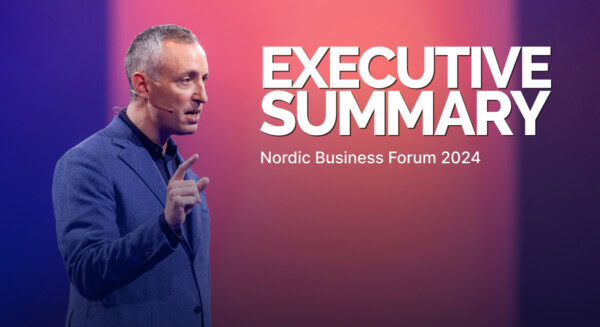7Nov2024
Leaders are constantly challenged to adapt, pivot, and lead their teams through ongoing change. Whether dealing with technological advancements, shifting markets, or societal shifts, the ability to lead change has become one of the most valuable skills for today’s leaders. Building a change-ready mindset—one that embraces adaptability and continuous learning—is essential to become resilient and grow within any organization.
Although change was not our main theme at Nordic Business Forum 2024, many of the speakers addressed their topics from the perspective of change. We combined these learnings into the 4 key traits leaders need to navigate constant change.
1. Curiosity
A core trait of a change-ready leader is a commitment to curiosity. In an unpredictable world, leaders who embrace curiosity and a desire to learn continuously are better equipped to lead their teams through shifting challenges.
As Brené Brown emphasized at Nordic Business Forum 2024, “If you have created a culture in your organization where being a ‘knower’ is of greater value than being a ‘learner’, you are set up to fail.” Additionally, Morten Hansen underlined how essential it is for tomorrow’s leaders to have an open mind and commit to continuous learning.
This shift—from needing to “know everything” to embracing learning and exploration—helps leaders remain flexible in the face of the unknown.
-> How to Commit to Curiosity:
1. Encourage questions, not just answers
Create an environment where your team feels comfortable asking questions. Promote a culture where questions are valued and seen as pathways to learning, rather than as gaps in knowledge. This approach allows everyone to contribute openly without fear of judgment.
2. Lead by example
Be transparent about your own learning process. Share moments where you’ve faced uncertainty or where you’ve taken time to investigate a new concept. By demonstrating curiosity yourself, you signal to your team that learning is a strength, not a weakness.
3. Host regular “curiosity sessions”
Set aside time for your team to explore new ideas, even if they’re outside their immediate responsibilities. These sessions can spark fresh thinking and foster a culture that values continuous growth.
2. Vulnerability
In an environment where change is constant, leaders must be willing to show vulnerability. Instead of presenting an image of “knowing it all,” change-ready leaders gain respect by admitting when they don’t have all the answers. At NBF 2024, Adam Grant underlined, “The best way to prove myself is to show that I’m willing to improve myself.” Showing vulnerability creates trust and openness, creating a safe space for the team to do the same.
-> How to Embrace Vulnerability:
1. Normalize mistakes as tools for learning
Rather than focusing solely on achievements, acknowledge both successful and unsuccessful efforts. Celebrate lessons learned from failures to reduce the stigma around making mistakes.
2. Encourage asking for advice
As Adam Grant said at the event, instead of asking for feedback, try asking for advice. “If you ask for feedback, people look to the past… If you ask people for advice, you get more actionable specific guidance.” This approach turns feedback into a forward-looking, constructive exercise rather than a critique of past actions.
3. Host open forums for shared learning
Create structured spaces where team members can discuss challenges and lessons they’ve learned. Open discussions can build a culture of shared learning and encourage others to view vulnerability as a strength.
3. Emotional Agility
Change-ready leaders need to maintain resilience without compromising their mental and emotional health. Brené Brown highlighted the importance of recognizing emotional responses to change, saying, “If you’re going to lead, it’s essential to ask yourself: do you know your ‘go-to armor’ when feeling uncertain or vulnerable?” Leaders who can process emotions healthily can better guide their teams through challenging transitions and flexibly adapt to new circumstances.
-> How to Build Emotional Agility:
1. Start with self-awareness and self-leadership
Like Brené Brown said, people with an extraordinary amount of self-awareness and a capacity for metacognition are the ones who will flourish. Start with yourself to improve your own self-awareness, and share the tools and space for your team to do the same. When you understand how you behave and what works for you, you can also better lead yourself, which is a crucial starting point for any leader, according to Sanna Suvanto-Harsaae.
2. Provide support resources
Offering access to resources like coaching, counseling, or stress management workshops can equip teams with tools to handle pressure. Acknowledging that everyone experiences stress differently fosters a supportive environment.
3. Encourage reflection practices
Invite team members to participate in reflective exercises, such as journaling or mindfulness sessions, to help them understand and manage their emotional reactions to change. Leaders who support these practices create a more balanced and resilient team.
4. Model healthy responses to stress
Show your team how you handle pressure constructively. Openly discuss your own methods for managing stress, whether it’s through taking breaks, seeking support, or reassessing priorities. Modeling these behaviors encourages others to prioritize well-being and resilience.
4. Growth Mindset
A fundamental aspect of a change-ready mindset is a commitment to growth. Leaders with a growth mindset view each challenge as an opportunity to learn and improve, rather than something to be avoided. Adopting this mindset means shifting from an emphasis on perfection to a focus on progress and adaptability.
-> How to Encourage a Growth Mindset:
1. Commit to incremental progress
Morten Hansen highlighted the need for a marching metric—a goal that you are committed to reaching continuously in order to make incremental improvement every day. Acknowledge and reward incremental progress within the team. Recognizing small victories boosts morale and keeps team members motivated to keep improving.
2. Remember that leaders speak last
Many of the speakers, like Adam Grant and Liz Wiseman, urged leaders to ask questions from their team first to learn from their perspectives instead of providing their own opinions immediately. You can frame the goal and ask questions, but allowing your team to share their ideas first will likely ensure you get more than one perspective on the subject. And ultimately, new ideas and various perspectives are needed for growth and innovation.
3. Encourage lifelong learning
Support ongoing development by providing access to training, courses, and resources. Encourage team members to explore areas beyond their job descriptions, sparking innovation and a sense of shared growth.
4. Turn setbacks into learning opportunities
Like Adam Grant said, “You can’t change the D minus—it already happened. All you can do is try to ace the second score.” By focusing on how well individuals can recover from a setback, leaders instill resilience and a positive approach to challenges.
Want to Become a Better Change-Ready Leader?
In a world where change is constant, change-ready leaders are the ones who can guide their organizations with confidence and strength. By committing to curiosity, embracing vulnerability, building emotional agility, and promoting a growth mindset, leaders can create resilient and adaptable teams ready to tackle challenges.
The journey to becoming a change-ready leader is ongoing. Leaders who commit to self-improvement and support their teams in doing the same are the ones who will succeed. Take the first step towards self-improvement and join Nordic Business Forum 2025 with your team!

 by:
by: 

